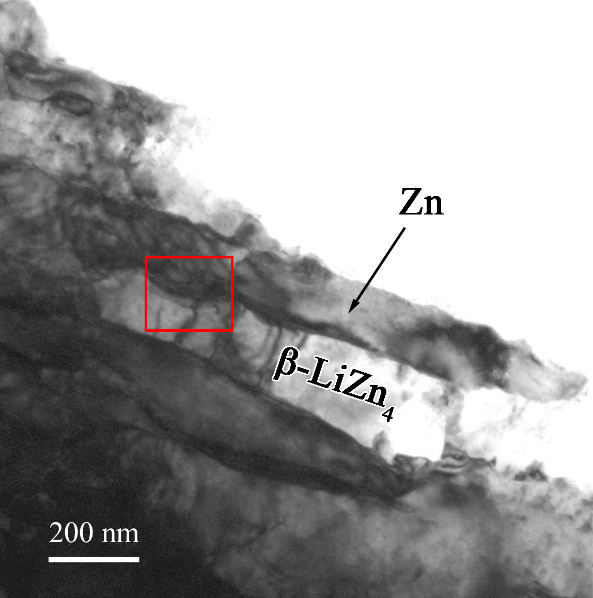
进行了TEM研究,进一步探索了β/Zn层状板结构的微观结构(图4)。明亮场(BF)TEM如图所示。图4a揭示了板条状的沉淀物平行分布在矩阵中。沉淀物的可重复的长轴表明,两相之间存在可重复的取向相对关系(OR)。图中的HRTEM图像4b显示了图中红色区域中的界面。图4b嵌入显示放大的快速傅里叶变换(FFT)滤波的两相显微图,它们都是六方最密堆积结构化的。锌的晶格参数为=0.2665nm,c=0.4949nm,c/a=1.86,而β相的参数为=0.278nm,c=0.439nm,c/a=1.58。在图中4b中板条状沉淀物的六方最密堆积结构沿[2110]区域轴定向,而基体的六方最密堆积结构沿[1213]区域轴定向。从HRTEM图像测量,板条样沉淀区域的晶格参数为=0.27nm,c=0.49nm,c/a≈1.8,表明它为Zn。相比之下,矩阵中的那些被测量为=0.27nm,c=0.43nm,c/a≈1.6,表明它是β相位。为了确定这两个相之间的部分,它们的FFT衍射图如图4c所示,它们的FTT图案在上面有绿色或红色点,可以在图4c中进行测量。该(1010)β与(0002)Zn逆时针偏离约4.5度。因此,两个相之间的OR可以描述为[1213]//[2110]βZn/(0002)Zn的(1010)β4.5。结果表明,层状结构是由固态相变形成的。
TEM investigation was carried out to further explore the microstructure of the β/Zn lamellar structure (Fig. 4). Bright field (BF) TEM image is shown in Fig. 4a, revealing that lath-like precipitates with paralleled long axes distribute in the matrix. The reproducible long axes of the precipitates indicate there exist reproducible orientation relationship (OR) between the two phases. HRTEM image in Fig. 4b shows the interface in the red square marked region in Fig. 4a, and the insets show enlarged fast Fourier transformed (FFT) filtered micrograph of the two phases. Both of them are HCP structured. Lattice parameters of Zn are a = 0.2665 nm, c = 0.4949 nm, with c/a = 1.86, while those of β phase are a = 0.278 nm, c = 0.439 nm, with c/a = 1.58. In Fig. 4b, the HCP structure of the lath-like precipitate is oriented along [2110] zone axis, while that of the matrix is orientated along [1213] zone axis. Measured from the HRTEM image, lattice parameters in the region of the lath-like precipitate are a = 0.27 nm, c = 0.49 nm, with c/a ≈ 1.8, indicating it is Zn. By contrast, those in the matrix are measured to be a = 0.27 nm, c = 0.43 nm, with c/a ≈ 1.6, indicating it is β phase. To determine the OR between the two phases, their FFT diffraction patterns are given in Fig. 4c. In order to guide pattern indexing, their FTT patterns are illustrated with green or red dots overlapped on it. It can be measured in Fig. 4c that (1010)β deviates about 4.5° anticlockwise from (0002)Zn. Hence the OR between the two phases can be described as[1213] //[2110] β Zn, (1010)β 4.5° from (0002)Zn. It is evidenced that the lamellar structure forms due to solid-state phase transformation.